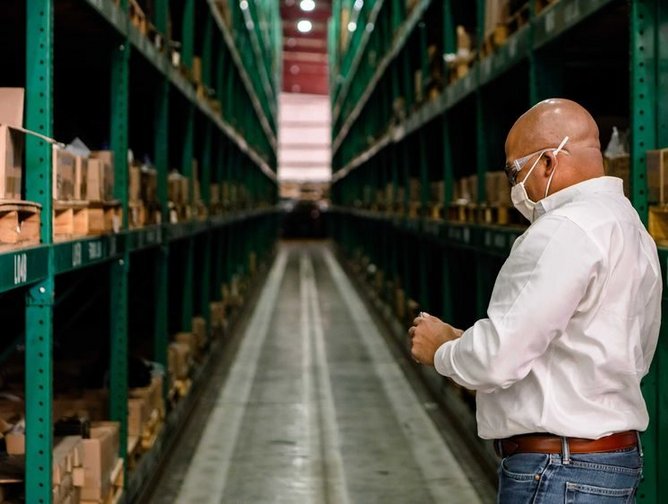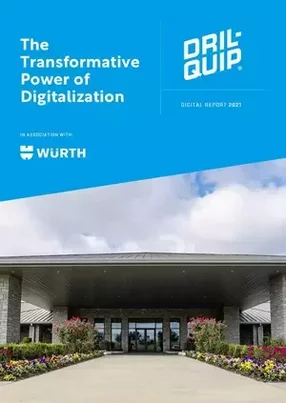Dril-Quip, a leading manufacturer of drilling and production equipment for some of the planet’s most challenging hydrocarbon development projects, is using technology as a differentiator. With multiple, innovative, award-winning products to its credit, the company has broadened its technology focus with advanced software and data science to digitalise supply chain operations.
To Michael Wells, Vice President Supply Chain, the willingness to embrace technology and march to its own tune are what separates Dril-Quip from its competitors and allows the company to forge new paths into an increasingly digital future.
“We're very proud of our past and extremely excited about our future,” he says. “Historically, we have differentiated ourselves from others in the market by focusing on developing game-changing technology and enhanced products that significantly improve well economics, decrease environmental and safety risks and reduce carbon footprint. Now, we are applying advanced technologies to supply chain digitalization to move further down the path to sustainability.”
Dril-Quip is built on a history of R&D and engineering exceptional products, but to remain relevant and competitive in today’s global market, action towards Environmental Social Governance (ESG) concerns and delivering an experience beyond the linear vendor mindset is key. These goals are central to Wells’ digitalization initiatives.
Wells joined Dril-Quip in November 2018 as its first supply chain vice president. Previously, he worked across every major industry apart from food and beverage, medical devices and healthcare, and he is bringing that multi-industry experience to bear upon Dril-Quip’s sophisticated but, until now, fragmented supply chain.
“I was brought in to help centralise everything from category management and sales and operations planning, to demand planning and traditional procurement,” Wells explains. “And what was interesting is that, what started off as a disadvantage, being a little bit behind our market in terms of centralising supply chain, became a massive advantage. That’s because of two things. First, we didn't have an entrenched culture that we had to fight against from a supply chain standpoint. Second, we didn't have the disadvantage of being the first mover in supply chain when it came to digitalization, so we were able to learn from a lot of other people's mistakes.”
[sub head] The three ‘legs’ of digitalisation
Dril-Quip manufactures a broad range of highly engineered products, including subsea and surface wellheads, subsea and surface production trees, mudline suspension systems, specialty connectors, liner hangers, drilling and production riser systems, tie-back and blow-out preventor connectors and more ─ a comprehensive list that would fill dozens of column inches. Its primary customers are the major operators, integrated large independent, and foreign national oil and gas companies throughout the world. Ensuring these customers’ equipment needs are met involves an enormously complex network of vendors and other partners.
Digitalisation of the supply chain has been key to ensuring this network not only runs smoothly but adapts and evolves over time. Wells depicts digitalisation as a table supported by three legs, the first of which is data engineering. He draws a parallel here to Dril-Quip’s manufacturing and inventory processes: taking raw steel, transforming it through work centres and routing, and producing a finished product for the end user. “It’s the same thing with master data and data engineering,” he says. “We have a master data process where we have this raw data and the metadata tied to it, and we put it through a series of processes in our system to get to the point where it becomes useable. It’s the exact same process that we would use for raw material.”
The second leg is the data analysis that turns finished data from the data engineering team into information, insights, and descriptive data that can be used to make decisions.
Wells’ third leg ─ predictive and prescriptive analytics ─ closes the loop. “We use insight from analytics to predict a lot of things, not only for the customer, but for the supplier. And we are able to use that insight to help influence how we work with our customers and how we work with our suppliers.”
So, what was the aim of this significant investment in data science? “We saw digitalisation as a way for us to use the exact same processes with fewer resources more effectively and more efficiently than our competitors and to deliver products to our customers in a more consistent manner,” Wells says.
Time was also an important factor in the digitalisation equation – a form of currency that Wells wants to spend developing the more intangible, though no less important, facets of the business: ESG goals for environmental stewardship and diversity and inclusion.
“In supply chain, your day is usually split into two types of things: your goals and 'the storm’, which are the day-to-day tasks and challenges that come up. Now, to reach your goals, you must act upon those challenges effectively. Unfortunately, the storm often acts upon you if you don’t have the tools in place to rapidly resolve issues. With the proper processes, programs, and protocols in place, it is possible to make consistent progress instead of wasting valuable time dealing with the storm of the day. Two of the massive goals of our organisation focus on ESG ─ environmental sustainability and diversity and inclusion ─ but these are goals that are not typically achieved organically; we must take action to accomplish them.
“When we create time, like we are doing through digitalization, we gain a valuable resource that enables us to invest in, and act upon, our commitment to the critical practices and procedures and reasonable controls required throughout the supply chain, including contracts, processes, people, and suppliers at our worksite, to promote environmental sustainability. It is essential that we allow our folks to find and exploit those opportunities when it comes to reducing the carbon footprint of our operations, as well as help our customers reach their carbon reduction targets.”
Diversity and inclusion (D&I) is another ESG goal that is close to the heart of both Wells and the company at large. Dril-Quip is working to increase the number of its employees that come from underrepresented groups and has developed outreach programmes with universities and nonprofits to support a more diverse pool of talent.
“By streamlining operations, we have time to positively change direction. Digitalization is an enabler because it provides the time necessary to advance these principles that we are 100 per cent committed to. We are convinced that our D&I initiatives will not only make us a better and more profitable company, but will improve our impact on society, culture, and the environment.”
[sub head] Profiting through partnerships
According to Wells, Dril-Quip sees tremendous value in working with other like-minded companies to pursue mutually important objectives. Partnerships play a critical role, not just in fulfilling supply or services to support Dril-Quip’s day-to-day business functions, but also in shaping the company’s future.
“We don't look at our suppliers as vendors. We buy hot dogs from vendors,” Wells jokes. “We don’t just say to them, ‘Just give us what we ordered, and we’ll pay for it’. We want something more from our suppliers and vendors; we want partners that truly connect with us. Traditionally, what you see is that a partnership is very ‘give and take’. It goes, ‘We want this, we want this, we want that’. What we're trying to do is move towards an achievement-orientated relationship with our suppliers where we are working together toward the same goals.”
Würth, a leading supplier of everything from chemicals and components to tools, screws, and fasteners, is one such strategic partner that illustrates how this process of defining and working towards shared goals is working well. “With Würth, it's not them telling us what they're doing and how they're going to do it. It's not us telling them what we're doing, how we're going to do it. It's a shared sense of improving things for both companies by asking, ‘Why are we doing this?’.”
Collaboration between aligned partners is nothing new in business, but Wells explains that sharing values is not enough. In a healthy relationship, participants do not simply go with the flow. Wells is not only comfortable with constructive criticism, he encourages it.
“The most important question we ask is not, ‘Who is right?’, but ‘What is right?’,” he says. “Würth feels comfortable telling us where we're missing the mark because we've developed that relationship, and we're comfortable enough to listen to them because we value their opinion, and that’s powerful. That's a powerful way of looking at a partnership: to be able to say, ‘You supply us, and we're the customer, but your opinion is respected so much that if you think we are wrong, we're going to listen’. We default on curious, and we want to encourage our partners to continue to share their ideas and insights.”
Wells believes these goals will pay dividends financially and in the way they impact stakeholders, even though the goals are not explicitly tied to cost-savings or revenue generation.
[sub head] Digitalization evens the playing field
In Wells’ estimation, digitalization has become an “equalizer”, lowering the barrier of entry for smaller, minority-owned, and local suppliers to engage in the oil and gas industry, where once the high level of required capital cut them off. “With the focus of digitalization, these suppliers are on an even playing field, whether they are a $5m company or a several billion-dollar company.”
In the coming 18 months, Wells hopes to lean further on digitalization to anticipate customer demands and help shape their futures. Like an athlete, he says that “when a customer thinks they want something, we start warming up.” That means taking stock of the playing field and assessing the assets of the team to identify strengths and shortcomings to make the best start. “It doesn't mean we're jumping into the game. It doesn't mean we know what action we’ll take, and it doesn't mean we're committed to doing anything just yet. It does mean that when the customer calls on us, we can move quickly. We can get in the game right away, without any hesitation. Digitalization is the underlying strength that allows us to do that.”



